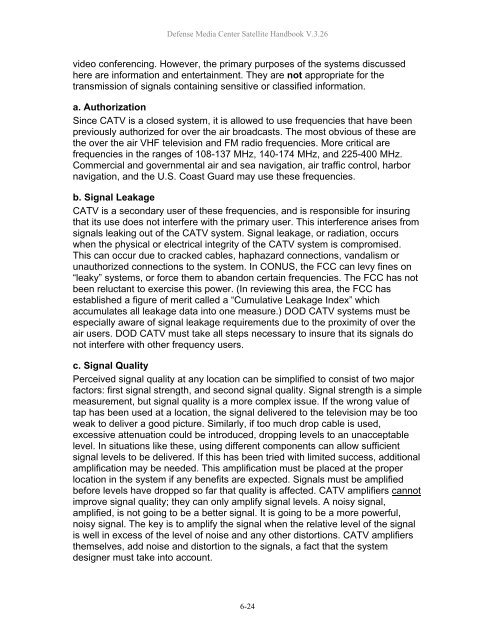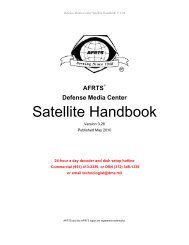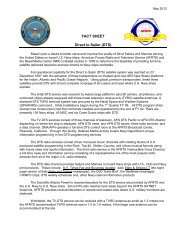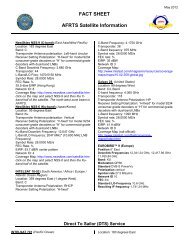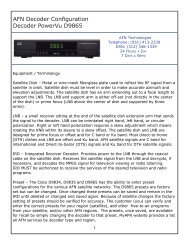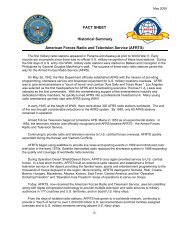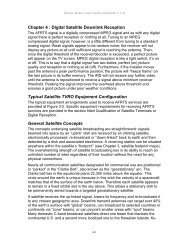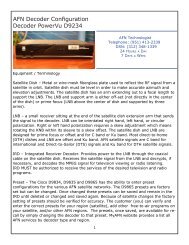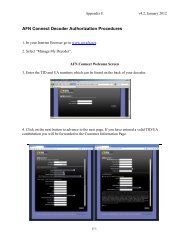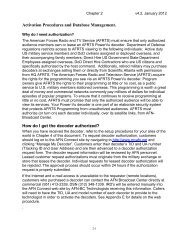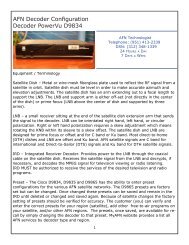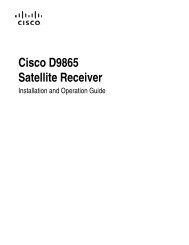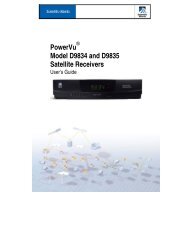AFRTS Defense Media Center Satellite Handbook
AFRTS Defense Media Center Satellite Handbook
AFRTS Defense Media Center Satellite Handbook
Create successful ePaper yourself
Turn your PDF publications into a flip-book with our unique Google optimized e-Paper software.
<strong>Defense</strong> <strong>Media</strong> <strong>Center</strong> <strong>Satellite</strong> <strong>Handbook</strong> V.3.26<br />
video conferencing. However, the primary purposes of the systems discussed<br />
here are information and entertainment. They are not appropriate for the<br />
transmission of signals containing sensitive or classified information.<br />
a. Authorization<br />
Since CATV is a closed system, it is allowed to use frequencies that have been<br />
previously authorized for over the air broadcasts. The most obvious of these are<br />
the over the air VHF television and FM radio frequencies. More critical are<br />
frequencies in the ranges of 108-137 MHz, 140-174 MHz, and 225-400 MHz.<br />
Commercial and governmental air and sea navigation, air traffic control, harbor<br />
navigation, and the U.S. Coast Guard may use these frequencies.<br />
b. Signal Leakage<br />
CATV is a secondary user of these frequencies, and is responsible for insuring<br />
that its use does not interfere with the primary user. This interference arises from<br />
signals leaking out of the CATV system. Signal leakage, or radiation, occurs<br />
when the physical or electrical integrity of the CATV system is compromised.<br />
This can occur due to cracked cables, haphazard connections, vandalism or<br />
unauthorized connections to the system. In CONUS, the FCC can levy fines on<br />
“leaky” systems, or force them to abandon certain frequencies. The FCC has not<br />
been reluctant to exercise this power. (In reviewing this area, the FCC has<br />
established a figure of merit called a “Cumulative Leakage Index” which<br />
accumulates all leakage data into one measure.) DOD CATV systems must be<br />
especially aware of signal leakage requirements due to the proximity of over the<br />
air users. DOD CATV must take all steps necessary to insure that its signals do<br />
not interfere with other frequency users.<br />
c. Signal Quality<br />
Perceived signal quality at any location can be simplified to consist of two major<br />
factors: first signal strength, and second signal quality. Signal strength is a simple<br />
measurement, but signal quality is a more complex issue. If the wrong value of<br />
tap has been used at a location, the signal delivered to the television may be too<br />
weak to deliver a good picture. Similarly, if too much drop cable is used,<br />
excessive attenuation could be introduced, dropping levels to an unacceptable<br />
level. In situations like these, using different components can allow sufficient<br />
signal levels to be delivered. If this has been tried with limited success, additional<br />
amplification may be needed. This amplification must be placed at the proper<br />
location in the system if any benefits are expected. Signals must be amplified<br />
before levels have dropped so far that quality is affected. CATV amplifiers cannot<br />
improve signal quality; they can only amplify signal levels. A noisy signal,<br />
amplified, is not going to be a better signal. It is going to be a more powerful,<br />
noisy signal. The key is to amplify the signal when the relative level of the signal<br />
is well in excess of the level of noise and any other distortions. CATV amplifiers<br />
themselves, add noise and distortion to the signals, a fact that the system<br />
designer must take into account.<br />
6-24


